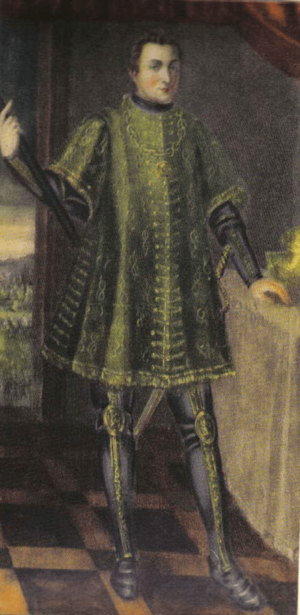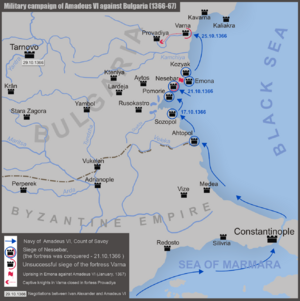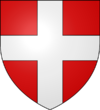Amadeus VI, Count of Savoy facts for kids
Quick facts for kids Amadeus VI |
|
|---|---|
 |
|
| Count of Savoy | |
| Reign | 1343–1383 |
| Predecessor | Aymon |
| Successor | Amadeus VII |
| Born | 4 January 1334 Chambéry, County of Savoy, Holy Roman Empire |
| Died | 1 March 1383 (aged 49) Castropignano, Kingdom of Naples |
| Spouse | Bonne of Bourbon |
| Issue | Amadeus VII of Savoy |
| House | Savoy |
| Father | Aymon, Count of Savoy |
| Mother | Yolande of Montferrat |
Amadeus VI (born January 4, 1334 – died March 1, 1383) was a powerful ruler known as the Green Count. He was the Count of Savoy from 1343 until his death in 1383. Amadeus was the oldest son of Aymon, Count of Savoy, and Yolande Palaeologina of Montferrat. Even though he started ruling with help from others because he was so young, he quickly became a strong leader. He helped the County of Savoy become an important power in Europe, both in politics and in its military strength. He even took part in a special military campaign called a crusade against the Turks who were expanding into Europe.
Contents
Becoming Count
When Amadeus's father passed away in 1343, Amadeus became the Count of Savoy. He was only nine years old at the time. His father had arranged for two cousins, Amadeus III of Geneva and Louis II of Vaud, to help him rule as co-regents. These regents agreed to a document that limited their power. They couldn't make big decisions without each other. All their choices also had to be approved by a council of nobles.
Soon after Amadeus became count, his cousin Joan of Savoy tried to claim the County of Savoy for herself. Her claim had been denied before, but she tried again. She passed away the next year, but in her will, she left the county to Philip, Duke of Orléans. In 1345, Amadeus made a deal with Philip. Philip gave up his claim to the county in exchange for money each year.
Amadeus received a good education. He learned how to fight and ride horses well. He also studied important books about military strategy and how to be a good ruler. He was also very religious. He often asked to fast, but it wasn't good for his health. So, Pope Clement VI told him he didn't have to fast so much. Instead, the Pope asked him to feed twelve poor people every week.
In 1347, Amadeus helped his cousin James of Piedmont. James was fighting against John II, Marquess of Montferrat and others who were trying to take land from Queen Joanna I of Naples. Amadeus sent an army, and they pushed back the attackers. Amadeus even joined the fighting himself for a few weeks.
From 1348 to 1351, a terrible sickness called the Black Death spread through Savoy. In some villages, half the people died.
In 1349, Amadeus made an agreement with his cousin Amadeus of Geneva, James of Piedmont, and the House of Visconti from Milan. This agreement was for mutual defense and help. As part of this treaty, Amadeus's sister, Bianca of Savoy, married Galeazzo II Visconti. To celebrate this marriage in 1350, Amadeus created a special group called the Order of the Black Swan.
Also in 1349, Humbert II, the last ruler of a nearby region called the Dauphiné, gave his title and land to the future King Charles V of France.
The Green Count's Rule
In 1350, a bishop named Guichard Tavel, who was an ally of Savoy, tried to take away some rights from nobles in a region called Valais. He was attacked, and many peasants rose up against him. Amadeus sent his army to help. In March 1352, Amadeus gathered a large army and quickly took control of the valley. The rebels gave up, and Amadeus brought the area back under his family's control.
In the summer of 1352, a noble named Hugh of Geneva started an old fight with Savoy again. Amadeus of Savoy then made an alliance with Albert II, Duke of Austria for help in conflicts. Amadeus gathered his army from his Italian lands. As they were crossing the Alps, the rebellion in Valais started again. Amadeus turned his army there first and defeated the rebels on November 3. The next morning, he was knighted. His army then took over the city of Sion and made its citizens pay heavy fines.
Amadeus earned his nickname, the Green Count, when he celebrated his 19th birthday. He appeared in a series of tournaments wearing green feathers on his helmet, a green silk tunic over his armor, and his horse had green coverings. He rode in with eleven knights, all dressed in green, each led by a lady also dressed in green. From then on, green was his favorite color for his clothes and for his court.
In 1353, Amadeus prepared his army to attack the Dauphiné. The King of France, John II, stepped in and arranged a truce. However, Hugh immediately broke the truce. Amadeus fought Hugh's forces and burned the city of Gex. The fighting continued until April 1354, when Amadeus finally defeated Hugh's army.
In a treaty signed in Paris in 1355, Amadeus agreed to trade some land. In return, he was recognized as the undisputed ruler of Faucigny and Gex. He also became the lord over the Counts of Genevois. These titles had been argued about for a long time. Amadeus also made the Marquess of Saluzzo pay him tribute, which meant his rule now reached the Italian side of the Alps.
Amadeus was also known for buying the important mountain pass called the Col de Largentière, which is now the Maddalena Pass. This pass was very important for trade and military movement because it connected Lyon with Italy. It provided an easy route between Piedmont and the Barcelonnette valley, which became part of Savoy.
These actions made Amadeus an important figure in the politics of Northern Italy. He was even asked to help settle a long-standing argument between the Republic of Genoa and the Republic of Venice over an island called Tenedos. It was decided that the island should be given to the Count of Savoy to hold.
The Crusade

In 1366, Amadeus started a smaller military campaign called a crusade. He took 15 ships and 1,700 men to fight against Murad I of the Ottoman Empire. He wanted to help his cousin, John V Palaiologos, who was the Byzantine Emperor. In this campaign, Amadeus joined forces with others, including the Hungarian king Louis the Great. They managed to drive the Turks out of a city called Gallipoli. However, this victory didn't last long, as the Turks took Gallipoli back a few years later.
At this time, Emperor John V was being held captive by the Bulgarians. Amadeus then turned his forces towards Bulgaria. He captured the Black Sea ports of Mesembria and Sozopolis. He then surrounded the city of Varna and sent a message to the Bulgarian ruler, Tsar Ivan Alexander. He told the Tsar to release John V or face more defeats. Ivan Alexander released John V, and Amadeus returned to Mesembria with the Emperor before Christmas.
Later Years
From 1372 to 1373, Amadeus fought in Italy alongside Enguerrand VII, Lord of Coucy. They were part of the Papal forces fighting against the Visconti family.
In 1377, Amadeus ordered the first public mechanical clock to be installed in his region. He also created a system to help the poor, which was one of the first of its kind in the late medieval period.
In 1381, in the city of Turin, Amadeus helped make peace between Genoa and Venice. He supported the peace treaty that ended the War of Chioggia and the larger Venetian-Genoese War. Later, Amadeus was convinced by Antipope Clement VII to go on a trip to Naples with Louis I, Duke of Anjou. In 1382, Amadeus and Louis successfully took over parts of Abruzzi and Apulia. Amadeus died near Castropignano on February 27, 1383. He was buried at Hautecombe Abbey on June 15, 1383.
Family Life
Throughout his younger years, there were many discussions about who Amadeus would marry. In 1338, he was engaged to Margaret of Bohemia, who was three years old. From 1340 to 1344, he was engaged to Joanna of Bourbon. In 1347, he ended that engagement and became engaged to Joan of Burgundy. She was brought to the court of Savoy to be raised. In 1351, Amadeus even tried to marry Isabella, the daughter of the King of England. Joan of Burgundy stayed at the court until 1355, when she was sent to live in a convent.
Amadeus eventually married Bonne of Bourbon in Paris in 1355. She was the sister-in-law of Charles V of France. They had three children:
- A daughter, born in 1358, who died after only a few weeks.
- Amadeus VII (born March 1360 – died November 1, 1391). He later married Bonne of Berry.
- Louis of Savoy, born in late 1364, who died before the end of that year.
In Literature
Amadeus is an important character in the novel La luce di Orione (2007) by Valerio Evangelisti. He is also a supporting character in the Chivalry series by Christian Cameron. His nickname, The Green Count, is even the title of the third novel in that series (2017).
See also
 In Spanish: Amadeo VI de Saboya para niños
In Spanish: Amadeo VI de Saboya para niños


